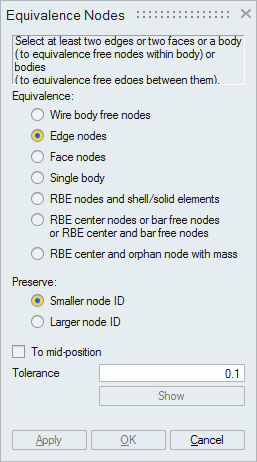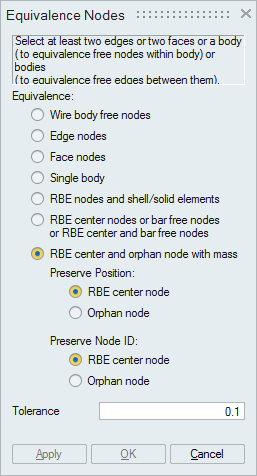Equivalence
![]()
Equivalence

Equivalences or finds duplicate nodes of selected bodies or faces or edges within a tolerance.
Equivalencing the coincident nodes removes the duplicated nodes and redefines any elements to reference the single retained node. Since this operation can potentially destroy elements referencing the removed nodes, Show option is available to identify the nodes found to be coincident. If necessary, the tolerance can be adjusted, to prevent collapsing elements or other unwanted changes to your model. Wire body free nodesThis option is used to equivalence wire body free vertex nodes. The vertex nodes that lie within the tolerance will get equivalence.
Edge nodesThis option is used to equivalence nodes on edges. Users can give bodies, faces, or edges as input.
- When a single shell body is given as input, the duplicate nodes on free topological edges of the body will get equivalence.
- When two or more shell bodies are given as input, the duplicate nodes on free topological edges across bodies will get equivalence.
- When faces are given as input, the duplicate nodes on the topological edges of the faces will get equivalence.
- When edges are given as input, the duplicate nodes on the given edges will get equivalence.
- When wire/bar bodies are given along with shell/solid bodies as input, duplicate nodes on the topological edges of the wire/bar will get equivalence to the shell/solid bodies.
This option is used to equivalence the duplicate nodes on the faces between bodies. You can give shell or solid bodies or faces or face groups as input.
Single body
This option is used to equivalence the duplicate nodes within a body. It will remove the duplicate nodes from 2D as well as 3D elements.
RBE nodes and shell/solid elementsThis option is used to equivalence the duplicate nodes between RBE bodies and shell/solid body. Shell/solid body node will be retained. You can give multiple RBE bodies and a shell/solid body as input.
RBE center nodes or bar free nodes or RBE center and bar free nodesRBE center nodes or bar free nodes or RBE center and bar free nodes, which lie within the given tolerance will get equivalence.
- When RBE bodies are given as input, the duplicate centre nodes between the RBEs will get equivalence.
- When bar bodies are given as input, the duplicate free nodes will get equivalence.
- When RBE and bar bodies are given as input, all the duplicate RBE center nodes and bar free nodes will get equivalence.
RBE center and orphan node with mass

This is used to equivalence duplicated orphan node with RBE center node. Only the orphan nodes that is assigned a mass load will get equivalence. The node position and ID to retain from the RBE center node or orphan node can be set by the user.
Preserve
Smaller node ID: This will equivalence at the location of the node with the smaller ID and retain the smaller ID.
Larger node ID: This will equivalence at the location of the node with the larger ID and retain the larger ID.
To mid-position
This is used to equivalence at the midpoint of the two nodes.
Tolerance
The tolerance used to find neighboring nodes to equivalence. If multiple nodes are found within this tolerance they are considered coincident, and get equivalence.
Show
This is used to preview the duplicate nodes.